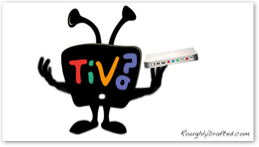





Why Apple Will Change TV presented similarities between the iPod and iTV, and introduced how Apple is poised to add value to existing content using the iTV in much the same way that the iPod added value to CD and MP3 music collections. Here's the third of Five Ways Apple Will Change Your TV.
The previous two articles looked at how the iTV is positioned to add value to on-demand commercial content and users' own personal content. What other kind of content is there?
#3: Alternative Content
Positioned between commercial content and personal content is what I'll call alternative content. It's not personal, but its not commercial either. It's shared content created by individuals: independent, amateur, and academic. Alternative content is huge, even if, like personal content, there's not usually a direct business model to support it.
There's a lot of existing examples of alternative content:
-
•Art and experimental film
-
•Student projects
-
•Audio and video podcasts
Many of these examples overlap, but they provide some idea of the long tail of content being produced, in many cases, for artistic, creative, educational, or political goals rather than simply for commercial enrichment.
The New Bubble

The highest web traffic in video today deals with this alternative video, and much of it is being funneled through sites like YouTube and Google Video, where anyone can upload shared content for free.
Who's paying for the hosting and distribution costs of video bandwidth? Either pre-failure dot coms or rich outfits like Google, speculatively burning through a lot of money attempting to stumble upon a viable business plan. They party like it’s 1999.
Ideally, companies hope to find a way to support these systems with advertising, or at least in some way funnel the huge amounts of generated traffic toward some sort of purchase. Little alternative content would support direct sales; its difficult to determine what parts might, and how they could be marketed.
Money for Nothing?
Hosting video is expensive. The trick is to figure out how to recover anything of value from this burning pile of money. Unfortunately, this tricky part shares a lot in common with the tricky part of cold fusion or perpetual motion: it’s a tantalizing idea but the solution has proven to be wholly illusive. 

Imagine opening a store in a high traffic mall without a clear business plan: high rent, lots of foot traffic guaranteeing a potential for sales, but no real idea of what is going to actually be sold. What to do? Start giving things away for free! Oh wait, that doesn’t solve a problem, it creates new ones!
Put billboards in the windows! Surely customers won't mind, and there must be a lot of advertisers happy to underwrite steep rent in order to have their name on a sign! Oh wait, that might not work out either. It doesn’t magically work on the web either.
The dotcom lapse of logic in delivering value for free without any clear opportunity to actually create a sale resulted in financial ruin for lots of investors just a half decade ago. Why are the same mistakes being made again? Because greed has a way of blinding even smart people; it works better than beer to cloud judgement.
Apple's Differentiation
Notice that Apple hasn't opened its own free video sharing site. There's simply no bankable value involved with hosting free videos, and considerable risk involved in hosting whatever content the public uploads, much of which invokes the wrath of copyright holders.
That doesn't mean that Apple can't participate in assisting Google and others to burn through their own cash. That's no doubt one of the issues Google and Apple are discussing: how Apple can help Google differentiate its video offerings.
For consumers, there's little reason to pick Google, Yahoo, YouTube or any of several other sites to host their video clips, or to go to those sites to look for video. Since they are all free, the main differentiators are:

-
•How well each works cross platform
-
•Quality and bandwidth each offers
-
•Ease of use and flexibility
-
•How strict each is about copyright issues
For suppliers, a marketplace where there is little differentiation means that customers will be hard to find and hard to retain. Online video is a cutthroat market just like PC hardware or mobile phone service:
-
•Raise the price and customers leave.
-
•Fail to match the features of every other provider and customers leave.
-
•Fail to offer the incentives of others and customers leave.
The difference is that online video currently isn’t making any revenues either! This market not only needs a business plan, but also desperately needs differentiation and new audiences. How can Apple add value to this mess?
Value Added
By offering Google Video a direct market into people's living rooms, Apple can allow Google to blow through its billions more effectively. Rather than duking it out one the web next to nearly identical competitors, iTV brings the alternative content Google hosts right into the living room.
Of course, Google Video isn't going to look amazing on TV, and certainly won't kill off cable and DVDs. However, there is a huge market for watching grainy home videos of teenagers jumping off roofs or repeat viewings of Peanut Butter Jelly Time.



If people on PCs put up with clicking through multiple pages of ads at eBaum's World in order to watch a funny video demonstrating some sort of natural selection in action, surely they would find such content a welcomed addition to their options for watching at home. Can anyone really get tired of watching boys fall off skateboards?
There’s no rocket science involved in displaying PC images on TV, but the market does appear ripe for a simplified system that just works.
Media Center has been largely rejected by consumers because its just too complex. By bringing the web to the TV using an interface as simple as the Tivo, Apple will be able to pull off something new.
Gain, No Pain
Front Row already links to Apple's movie trailer site. All Apple would need to offer on the iTV is an option to hook into either a specific alternative site, such as a partnership with Google Video, or a way to make any user-defined sites available.
Each site that wanted to partner with Apple’s iTV would only need to provide an RSS feed of videos available to the iTV. Apple could even allow partners to present their content next to their own ads, providing value to the network providing the free service.
By allowing the iTV to hook into any number of web services, Apple would benefit from the demand for alternative content without exposing itself to the risk of copyright infringement, because the iTV would only be providing access to an external service.
Further, it would turn Front Row into the interface of iTunes in the living room, just as the iPod is iTunes to go. By involving parters and opening up the potential of Front Row to work with third party options such as the EyeTV DVR, the Slingbox, and other products, Apple could create a lot of value for consumers.

Podcast to the People
The free video sites I've been talking about aren't the only sources of alternative content. Through its integration with iTunes, the iTV will already be able to access the alternative content Apple has been offering for some time now: podcasts. While audio podcasts are well paired to the iPod, video podcasts will be ideal for use with the iTV.
Apple currently doesn't have to do a lot to support podcasting; it simply hosts the text RSS feeds provided by others. The RSS feeds themselves only tell iTunes how to find the server where the actual audio or video sits; iTunes manages the work of downloading the requested episodes and copying them to the iPod.
Podcasting provides a way for indie filmmakers and journalists to find large audiences for their broadcasts. Now, instead of only being available on a PC or iPod, they'll have the additional ability to compete with commercial broadcasters for airplay right on users' TVs.
The Curiously Long Tail
In addition to independents, there is a huge library of free content created by governments or public broadcasting companies, as well as vintage content in the public domain. Imagine being able to draw upon a huge library of free video content, on demand. Until now, finding an audience for such obscure content has been a bit tricky.
Now, all that agencies, broadcasters, and archives need to do is host their content next to an RSS feed and allow iTV users to download it. If they're pressed for cash, they can always enlist Google to help host it.
Paid Alternative Content
Apple also has another way to involve itself more directly into alternative content: it could host a lot of this itself, charging a minimal fee for downloads.
By offering vintage and foreign movies for cheap, along with a lot of other obscure content of various kinds, Apple could serve as an archive for stuff that would otherwise never see the light of day. Of course, iTunes is already doing much of this for free.
Apple has both the distribution channel and the capacity to bill for content. By hosting an ever larger variety of alternative content, Apple can add a lot of value to the iTV and gain new audiences with diverse interests.
The World’s Oldest Professional Pictures
The true state of the art in information technology has frequently been trailblazed by sex, from literature to photography to film to home VCRs to Internet video.
While it sounds a bit scandalous for Apple to offer a pornography as a killer app on the iTV, the company could add a lot of value to a variety of alternative content by kicking down establishment’s door and erecting a sophisticated electronic gate instead.



Rather than porn being around every corner and accidently shoved at kids who are searching for Barney and Mary Poppins, Apple could make it possible for adults to access whatever content they wanted and set filters that would prevent their kids from stumbling into inappropriate programming.
The Internet itself has no boundaries; type a URL wrong and you'll instantly find yourself in a seedy part of town. With the iTV, Apple can offer a ratings limitation that allows all types of content providers to find their audience without offending people who aren't interested, and without risking liability for making alternative content available to minors. 





Apple already has ratings in place in iTunes, for TV and movies, as well as podcasts with explicit content.
Apple doesn't have to censor anything, but it can add value by putting tools in the hands of parents to manage what they want their kids to see.
What's Next?
So far, I've outlined three areas Apple will add value with the iTV by targeting new distribution or functionality for users:
3) Alternative content
But that's only the first three ways Apple is adding value with the iTV. Two more to come, so stay tuned for the fourth reason Apple will change TV in ways nobody else has been able.
This Series

Five Ways Apple Will Change TV: #3
Wednesday, October 4, 2006






Ad









 Bookmark on Del.icio.us
Bookmark on Del.icio.us Discuss on Reddit
Discuss on Reddit Critically review on NewsTrust
Critically review on NewsTrust Forward to Friends
Forward to Friends
 Get RSS Feed
Get RSS Feed Download RSS Widget
Download RSS Widget

